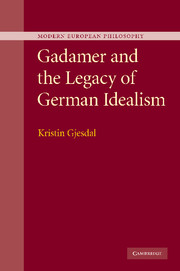Book contents
- Frontmatter
- Contents
- Preface
- Acknowledgements
- List of abbreviations
- Introduction
- 1 Art, dialogue, and historical knowledge: Appropriating Kant's Critique of Judgment
- 2 Beyond the third Critique: Epistemological skepticism and aesthetic consciousness
- 3 Overcoming the problems of modern philosophy: Art, truth, and the turn to ontology
- 4 History, reflection, and self-determination: Critiquing the Enlightenment and Hegel
- 5 Schleiermacher's critical theory of interpretation
- 6 Normativity, critique, and reflection: The hermeneutic legacy of German Idealism
- Bibliography of works cited
- Index
1 - Art, dialogue, and historical knowledge: Appropriating Kant's Critique of Judgment
Published online by Cambridge University Press: 06 August 2010
- Frontmatter
- Contents
- Preface
- Acknowledgements
- List of abbreviations
- Introduction
- 1 Art, dialogue, and historical knowledge: Appropriating Kant's Critique of Judgment
- 2 Beyond the third Critique: Epistemological skepticism and aesthetic consciousness
- 3 Overcoming the problems of modern philosophy: Art, truth, and the turn to ontology
- 4 History, reflection, and self-determination: Critiquing the Enlightenment and Hegel
- 5 Schleiermacher's critical theory of interpretation
- 6 Normativity, critique, and reflection: The hermeneutic legacy of German Idealism
- Bibliography of works cited
- Index
Summary
Any study of Gadamer's critique of German Idealism must begin with a discussion of his reading of Kant. The relationship between Gadamer's own tradition, that of twentieth-century phenomenology, and Kant's program for a transcendental philosophy is itself a complex issue. First there is Edmund Husserl, who was both attracted to and critical of Kant's first Critique. Then there is Heidegger and his ambition to survey the entire field of the three Critiques. However, most important in this context is Heidegger's reading of the Critique of Pure Reason in Kant and the Problem of Metaphysics (1929). Faithful to his notion of a salvaging destruction of the philosophical tradition, Heidegger argues that the earliest version of the first Critique, the so-called A-deduction of pure reason, is radically different from the epistemological position that had been eagerly promoted by the neo-Kantians. According to Heidegger, Kant was initially not interested in epistemology in the narrow meaning of the term. Rather, Kant was verging upon a genuine ontology of Being, but then felt forced to leave this path behind in order to pursue the transcendental conditions of knowledge. As for the second Critique, Heidegger approaches this work through a discussion of the Kantian notions of freedom and causality. What, then, of the third Critique, that is, Kant's aesthetics? There are scattered remarks about the Critique of Judgment throughout Heidegger's work from the early 1930s onward (especially in the late 1930s Nietzsche lectures, to which I return in Chapter 3).
- Type
- Chapter
- Information
- Gadamer and the Legacy of German Idealism , pp. 9 - 47Publisher: Cambridge University PressPrint publication year: 2009



